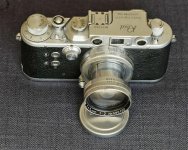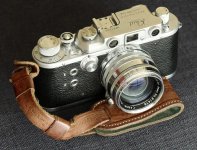wilsonlaidlaw
Member
Thank you for doing all this work. I recently re-acquired a Reid and Sigrist Model III type 2 LTM camera, after a gap of 50 years. Eventually I would like to get the correct Taylor Hobson 2 inch f2 Anastigmat lens but good copies of these come very expensive.
My alternative was a collapsible Summicron but all the ones I looked at had horrible cleaning damage to the front element. Contrary to what the sellers claim, this will affect the image quality, reducing contrast and increasing both flare and veiling glare.
I eventually decided on a chrome Canon 5cm f1.8 and have found a near mint one from Japan at just £135. I assume Canon's coating must be harder than Leica's as all the lenses I looked at seemed to have far less cleaning damage than the Summicrons or maybe Japanese owners look after them better! Supposedly the earlier chrome models of this lens, suffer less from separation and fogging than the later black barrel models.
BTW if you need a lens hood for the older Canon lenses with a 40mm filter thread, JJC now do a ventilated hood for the Fuji X10 camera, which has a 40mm filter thread. Part no. for the chrome model JJC LH-JX20S.
Here is a picture of the Reid with my 5cm Summitar attached, while I await the arrival of the Canon, currently stuck in French customs at Paris airport.
Wilson
My alternative was a collapsible Summicron but all the ones I looked at had horrible cleaning damage to the front element. Contrary to what the sellers claim, this will affect the image quality, reducing contrast and increasing both flare and veiling glare.
I eventually decided on a chrome Canon 5cm f1.8 and have found a near mint one from Japan at just £135. I assume Canon's coating must be harder than Leica's as all the lenses I looked at seemed to have far less cleaning damage than the Summicrons or maybe Japanese owners look after them better! Supposedly the earlier chrome models of this lens, suffer less from separation and fogging than the later black barrel models.
BTW if you need a lens hood for the older Canon lenses with a 40mm filter thread, JJC now do a ventilated hood for the Fuji X10 camera, which has a 40mm filter thread. Part no. for the chrome model JJC LH-JX20S.
Here is a picture of the Reid with my 5cm Summitar attached, while I await the arrival of the Canon, currently stuck in French customs at Paris airport.
Wilson





